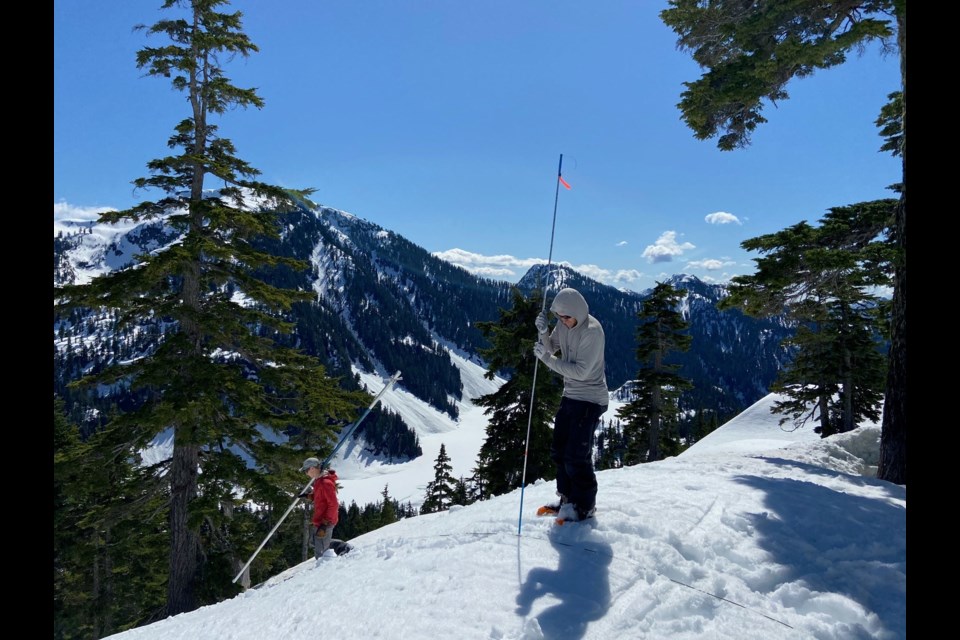La Nina has been good to snowpack levels in the North Shore Mountains this year.
Measurements taken in April in snow courses above the Lower Mainland’s three main reservoirs showed snowpack levels sitting at 120 per cent of normal, according to Metro Vancouver.
But come the summer, it will still be rain in the late spring months and water conservation measures that have the biggest impact on the region’s water supply.
Every year, Metro Vancouver crews fly to eight high-elevation stations in the region’s watersheds and measure snow depth to come up with a calculation of how much water is stored as snow.
Sites where snowpack is measured are located throughout the Seymour and Capilano watersheds. One of them is at the base of Grouse Mountain, another one is on Dog Mountain on Mount Seymour. “We have them right up to the mountaintops, in strategic locations where we can land a helicopter,” said Heidi Walsh, director of watershed and environmental management for Metro Vancouver’s water services. “We had a nice healthy snowpack this year.”
Since 2019, Metro crews have also been piloting a new way to measure snowpack that involves bouncing a high-resolution laser into the snow from a plane to obtain three-dimensional information. Those snowpack estimates will then be compared to those taken manually to see how accurate they are. Satelite images are also being piloted as ways to assess snowpack.
Snowmelt helps bolster the reservoir levels until July, when most of the snowpack on the Coast has melted.
But late spring rain and careful management make the biggest difference to water supplies later in the summer.
In late April, Metro crews raise the level of the dams in both the Capilano and Seymour reservoirs to store as much water as possible prior to summer. “It allows us to get just a few more metres of water storage,” said Walsh.
“It helps to make sure we can meet our summer demands, because quite often our summer demands are up to 50 per cent more than what we see in the fall.”
Much of that is due to lawn watering.
On some of the hottest summer days, water use in Metro Vancouver can spike at over 1.5 billion litres.
This week, summer-long watering restrictions – aimed at helping to conserve the region’s water supply – came into effect throughout Metro Vancouver. Lawn watering is allowed twice a week in the early morning hours – on Wednesday and Saturday from 4 a.m. to 9 a.m. for even-numbered houses and Thursday and Sunday from 4 a.m. to 9 a.m. for odd-numbered houses. Trees, shrubs and flowers can be watered from 4 a.m. to 9 a.m. any day with a sprinkler or anytime if watering by hand or using drip irrigation.
Tighter watering restrictions were brought in five years ago in the Lower Mainland, following a summer drought in 2015 that taxed water supplies.
Metro Vancouver manages three watersheds – Capilano, Seymour, and Coquitlam – which together provide water to about 2.6 million residents. Each of the reservoirs usually supplies about a third of the region’s water.
The Coquitlam reservoir – operated by BC Hydro – can supply up to half of the water during peak summer demand, under an agreement between BC Hydro and Metro Vancouver.
There are also three high-elevation alpine lakes in the watershed system – two in Seymour and one in Capilano – that can be opened in late summer to supplement water supplies.
“There may only be an extra two or three days’ supply in each one of those lakes, but we do open them up towards the end of the summer, just to replenish the lakes,” said Walsh.
About 60 per cent of water use in the Lower Mainland as a whole is residential. On the North Shore, residential use accounts for 80 per cent of water used in West Vancouver, while port industry consumes about 45 per cent of total water used in the City of North Vancouver.



